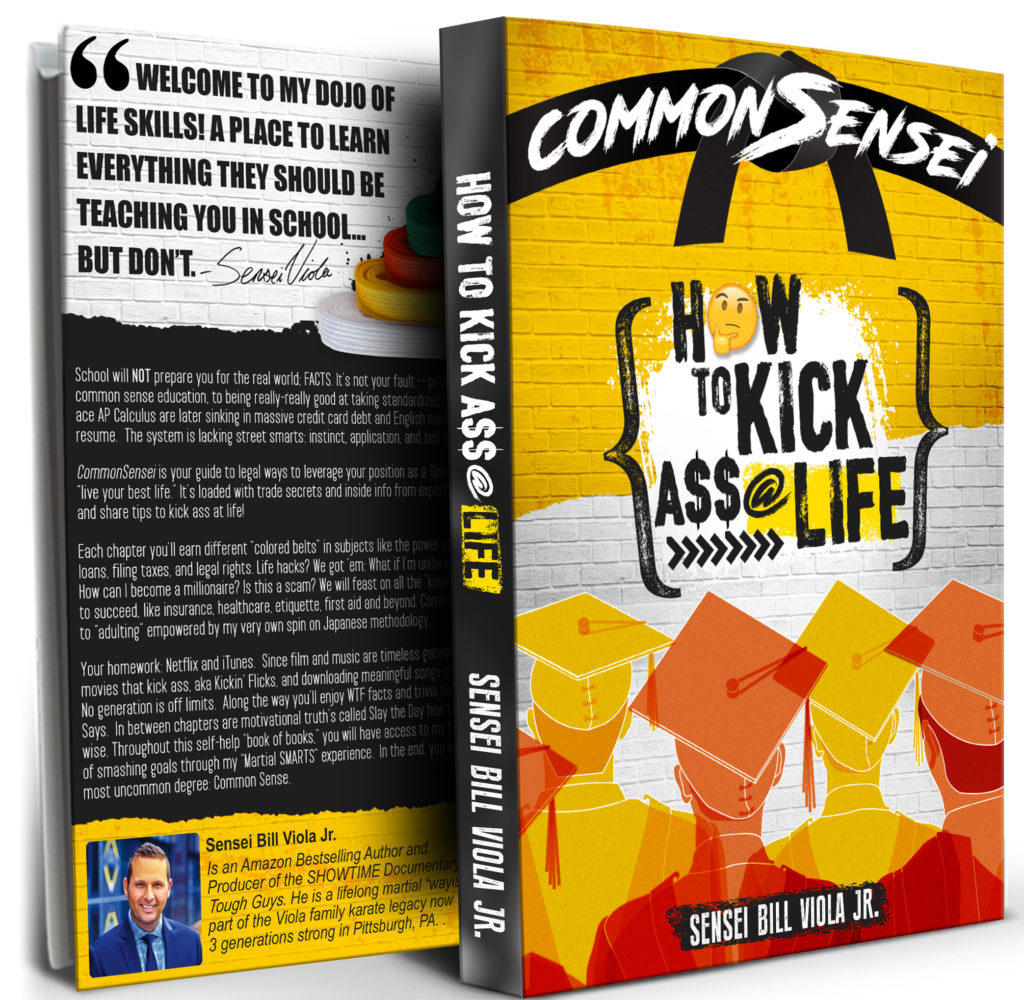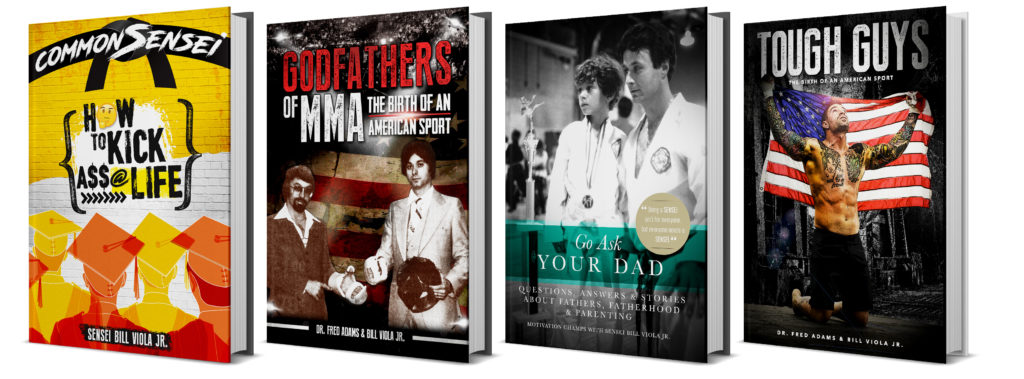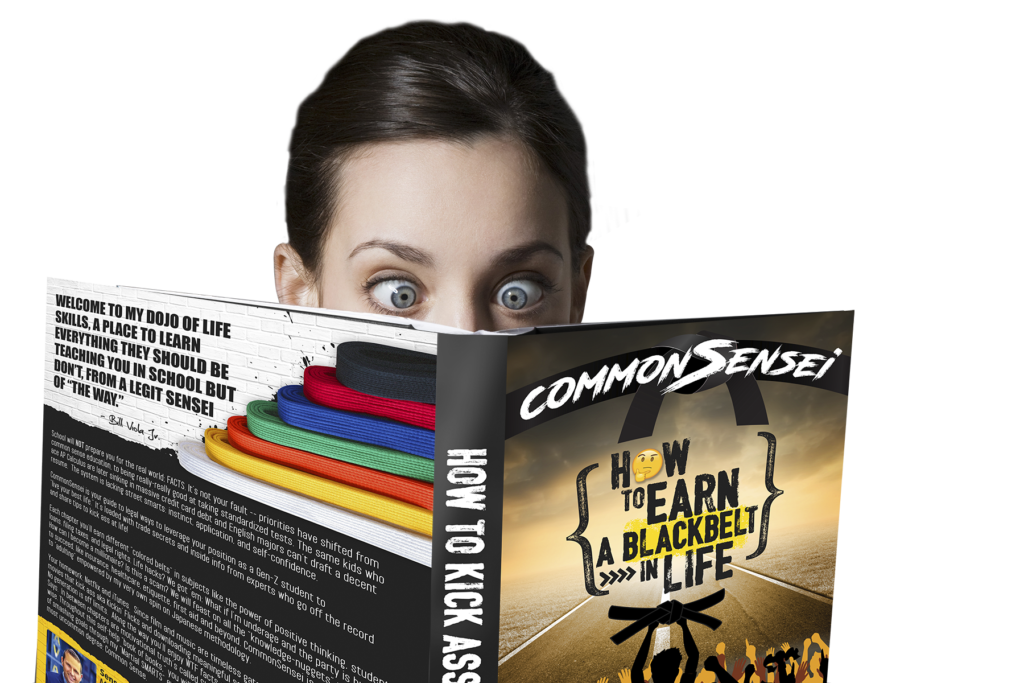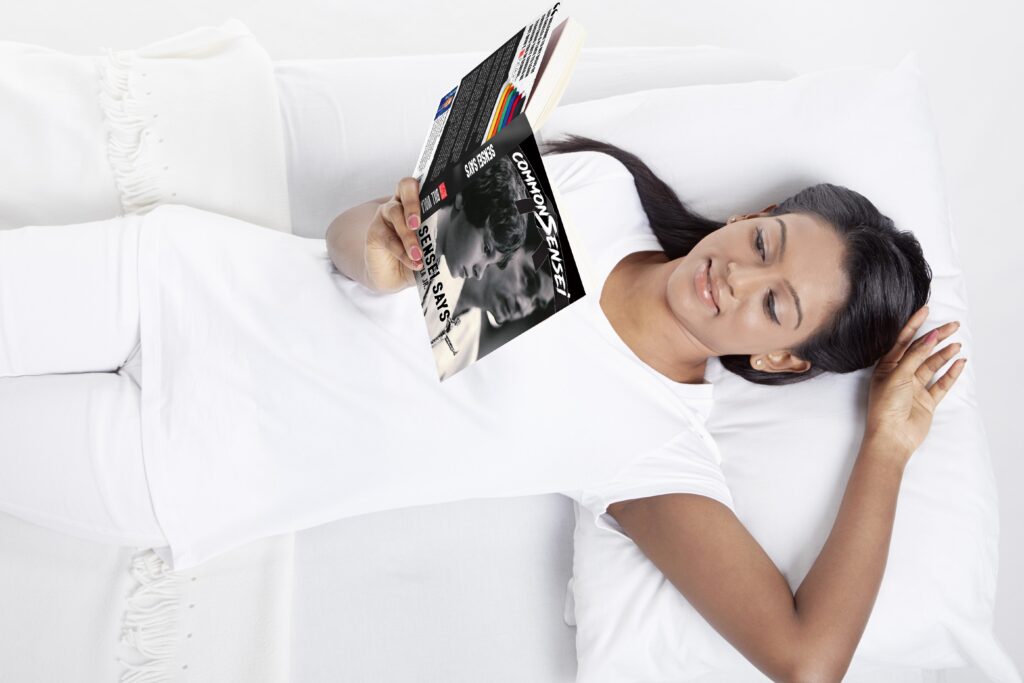Martial Wayist
Mixed “Martial” Misnomer?
By Bill Viola Jr. Senior Editor for MMA History.
Fight fans are still crying foul following the melee that was post McGregor/Nurmagomedov. Social media lit up with a barrage of disgust and disdain towards the so-called “martial” behavior of the fighters and their entourages–the same people who shelled out $64.99 to watch a grudge match promoted in the same vein of Vince McMahon’s WrestleMania. Regardless, it’s a blueprint “endeavor era” UFC has relished in and profited. Extracurricular insults of family, faith, and country (staged or not, you decide) have long been staples of the fight game, so the aftermath isn’t all that shocking. Testosterone fuels a consumer base with a penchant for bloodlust and revenge. Shock and awe fills seats and sells PPVs. It’s a dusty old playbook, but effective. Nonetheless, critics of yesteryear who chastise the most recent UFC spectacle are the same who revel in the days of Tyson gnawing on Holyfield’s ear or reminisce of Larry Holmes, soaring like an eagle long before Khabib drop kicked Trevor Berbick. Such antics are legendary and part of fabric of sports. Be it a bench clearing brawl in baseball or two hockey enforcers dropping the gloves, the raw emotion of the moment is revved by the thirst for violence.
So how is UFC’s outburst any different than NBA’s Ron Artest inciting the infamous Auburn Hills riot or MLB’s Roberto Alomar spitting in an umpire’s face? It isn’t, really, but ambiguity seems to surface because the term “martial arts.” Martial arts are subjective, largely due to Hollywood’s portrayal of ancient oriental teachings in a “death before dishonor” way. We’ve been fed the notion that deep down an authentic “martial artist” is always respectful and disciplined, and for nearly a century, America especially, has swallowed the rhetoric. The industry itself seized the moment and commercialized the arts by catering to children (The Karate Kid, Teenage Mutant Ninja Turtles, etc.). It became more about building self-esteem and less about fighting. McDojos and “pay to play” instructors tainted the arts with watered down systems and fast-track black belts for the right price, but those opportunists are for another discussion.
“Martial arts” today is a catch-all, almost generic term that universally and collectively describes any combat system from around the world. Commonly these arts are paired with East Asian etiquette, the premise of this article. The umbrella covers everyone from military and police to toddlers in little ninja tae kwon do classes to soccer moms taking self-defense. Widespread would be an understatement.
Up until the advent of the UFC, most martial artists were revered as ultimate role models, not ultimate fighters. The octagon changed the landscape, not because we haven’t seen bad behavior in the ring before, but because it was considered taboo for martial artists. The image of noble Samurai-esque karate-ka was largely replaced with a glorified roster of trash talking substance abusers, cheats, and domestic heathens; an unsavory cast of characters that push the envelope. It’s the culture of modern professional sports across the board. Side note: My former favorite Pittsburgh Steeler was recently accused of hurling furniture off a roof in a fit of rage, nearly killing a toddler. Regardless; he’s a football player not a martial artist. If he were a “martial artist” he would have displayed complete self-control! NO. Not anymore. Not ever, really. Akin to a yin yang, fighting (martial arts) and living a moral life (martial way) are polar opposites that can harmonize, but make no mistake; they are not one in the same. This conundrum is not mere semantics, and the UFC knows exactly how to exploit it.
Martial Arts / Bujutsu: *Bu 武 (war) 術 Jutusu (art, skill, science)
Martial arts has roots in prehistoric times, influencing every culture since the dawn of mankind. Fighting is embedded in our DNA, a transgression that leads to the inevitable: WAR. Paying homage to the Roman god of war, the “Arts of Mars” is a “kill or be killed” philosophy. Many arts are entwined deep within mythology, à la Pankration. My studies support the theory that Alexander the Great was a pervasive influence on primitive Martial Arts, and that his conquests likely spread the fundamentals of the Greek martial arts throughout the world, including India. Popular folklore glorifies an Indian Monk named Bodhidharma, a journeyman who traveled to China establishing Zen Buddhism in the 6th Century A.D. Many believe the training regimen he taught the Shaolin Monks later spread and impacted the development of modern (gendai) traditional martial arts around the world. Millennia later we see the fruits of their labor; an offspring of countless forms of armed and unarmed combat. The Japanese arts in particular have captivated a global audience. Regardless of what styles or theories you embrace, martial arts are obviously not the handiwork of one person, group, or culture; it has evolved over thousands of years and continues to evolve today. But remember, the sole purpose of martial arts is warfare—period.
Martial arts is a science to transform your body into a weapon. Here lay the Conor McGregors, Jon Jones, and Colby Covingtons of the sport. Promoting ethics isn’t their shtick; they fight, and they don’t give a damn what people think about physical or physiological tactics. It’s also big business, and business is boomin’. Conor has singled handedly raised the bar for profit sharing. Love or hate the persona, his acumen is next level genius. He is a martial artist who follows his “own” egocentric path. Spoiler; not all “martial artists” care about character, nor should they. Blasphemy you say, but hear me out.
Sometime around the 16th century a seismic shift took place, especially in Asia, where the “art of war” transcended from physical to metaphysical. Many arts began to adopt lifestyles of selflessness. The Samurai (literally meaning to wait upon) would live and die by a moral code. This metamorphosis was known as Budo (Martial Way). Masters began replacing the suffix “jutsu” with “do” instead. The arts were compartmentalized into physical and mental.
Martial Way / Budo: BU 武 Martial (war) DO 道 Way (path)
By the turn of the century, Jigoro Kano’s Judo (formerly jujutsu) and Karate-do became two of the most famous martial arts to adopt principles of morality. Tenets were embedded within each craft; largely to promote their brand to primary schools and universities. Bujutsu is intrinsically savage, but Budo emphasized sophisticated ethical guidelines–essentially the opposite of martial arts. Think of bujutsu as the skill to kill, while budo is a philosophy of self-control. Bujutsu is self-protection, whereas Budo is self-realization. Karate-do is a path or “way of life” guided by precepts of self-enlightenment (inner and outer peace). Learning karate without the “Do” is merely kicking and punching without consciousness. Gichin Funakoshi, the father of modern karate, preached “perfection of character” as the ultimate lesson. This methodology helped spread his art of Shotokan Karate-do around the world. Funakoshi was a martial artist who chose to be a “martial wayist.” Thus, a Dojo isn’t a martial arts school at all, it’s a place to place to learn “the way” (mastery of body, mind, and spirit) through its parent (bujutsu).
*Bugei a catch-all translation for Martial Arts (performance) that straddles both Jutsu and bu; often, it reflects the refinement of instruction. I’ll reserve the dissection of Bugei for another day. My emphasis is on “battlefield” Japanese martial arts prior to the Meiji Restoration (1868) and its successor, Budo. They undoubtedly have the most social impact. There are no official timelines, as elements of Budo have always existed even if not classified as so.
Post WWII, martial arts and martial way were prepackaged and shipped off to America. The separation between Jutsu and Do wasn’t transparent. If you were a martial artist, you also followed traditions of reverence with blind loyalty. That bond strengthened for decades. By the late 1970s, people began to question the legitimacy and effectiveness of many arts. Hollywood sensationalized martial artists as superhuman (i.e. Bruce Lee) and some people weren’t buying it. This unrest marinated until it reached a boiling point in 1979.
My father wrote the first codified set of mixed martial arts rules (although that term wasn’t used at the time) to settle the debate. He and his co-promoter Frank Caliguri invented the “Tough Guy” concept– they were simply tired of people degrading martial arts (calling it fake, useless etc.). They created a sport where all martial arts were in fact mixed, but calling it “martial arts” didn’t fit the narrative. Why? He and Frank were also martial wayists. They taught karate-do. This flavor of “anything goes” combined fighting was the opposite of what people perceived martial arts to be during the era. Instead, they took a disciplined approach to organizing streetfighters, brawlers and yes, self-proclaimed martial arts champions. Any combination of wrestling, boxing, karate, judo, jujutsu, and everything between was legal. It was an American brand of Vale Tudo with civilized rules. Wrestling and boxing notably had their own identity, so labeling it martial arts would have alienated fans and fighters. At the end of the day it was mixed martial arts and a humbling experience for many.
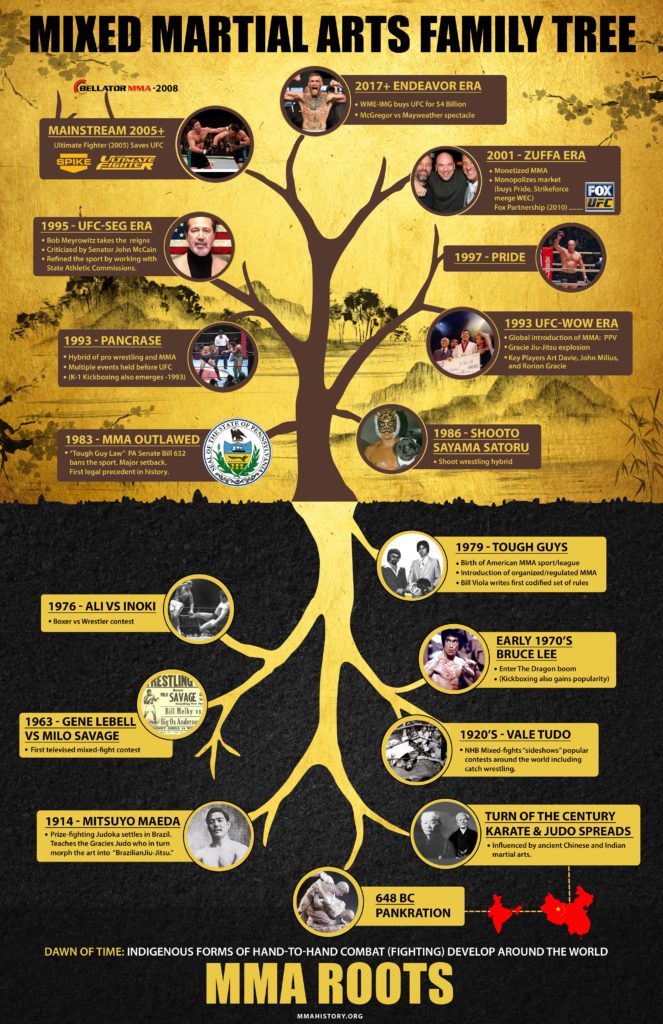
The league, (although groundbreaking in terms of regulation, rules, equipment, and scoring) retrospectively launched at the wrong place at the wrong time. The Godfathers of MMA were outlawed in 1983 by Senate Bill 632 (Tough Guy Law). A decade later UFC debuted. In a sense, UFC was a Tough Guy reboot without regulations, rules, equipment and scoring. It would take years to catch up to their forefathers, and donning the ominous name no-holds-barred, it was far from sport. As we all know, the image didn’t bode well.
Mixed Martial Arts (MMA > NHB)
MMA: It’s the abbreviation that saved a fledgling sport. The violent spectacles of UFC 1.0 were no longer apropos, so contemporary ultimate fighting needed a “PG” calling card. MMA was a simplistic acronym that conjured a clean, professional image. Martial artists, after all, are some of the most virtuous people on the planet, right? The nomenclature may have been accidental, divine inspiration, or just dumb luck, but it was the right place at the right time.
Colleagues of mine believe the term “mixed martial arts” originated from the pro-wrestling circles of the 1970s, although there is no conclusive evidence. The earliest mainstream usage comes from Pulitzer Prize winning journalist Howard Rosenberg, who may have inadvertently named the sport in his Los Angeles Times article: “’Ultimate’ Fight Lives Up to Name: Television: Pay-Per-View Battle, Instead of Being Merely Gory and Funny, Gets Interesting After the First Two Bouts.” (November 15th 1993). The excerpt reads,
“St. Louis cruiserweight boxer Art Jimmerson didn’t get to throw even one punch before giving up. He was swiftly taken down and dispatched with a chokehold by jujitsu master Royce Gracie, whose family is synonymous with the sport in their native Brazil, where mixed-martial arts championships like this one are commonplace.”
Unbeknownst to him, his casual albeit monumental classification would influence the course of a billion dollar business. Former UFC Commentator Jeff Blatnick began popularizing the term on-air in the 1990s in an effort to remove the stigma of violence. Loretta Hunt, author of the book, Let’s Get It On, claims that John McCarthy is responsible for naming the sport, stating its origin stems from an LAPD work permit that McCarthy filled out to work UFC 2. Hunt explained, “It was called ‘No Holds Barred’ or ‘Ultimate Fighting’ back in the early days. Himself and Jeff Blatnick – a former commentator for the UFC – came up with the ‘Mixed Martial Arts’ name, but it was John’s phrase. And Jeff Blatnick is the one who pushed it on the pay-per-views until people really started picking it up.” Regardless if it rose from the depths of catch-wrestling, a regional promotion, Rosenberg, Blatnik, or McCarthy, semantics saved the sport. The allure of budo gave UFC the facelift it desperately needed.
The emotions elicited by the cage and its extreme monikers were still vivid, but now the sport lay under the martial arts banner for acceptability. As a traditional Shotokan karate-do Sensei myself, I was initially uneasy with the “mixed” suffix adjoining martial arts in the ‘90s because of the aforementioned public misperception. I was a martial wayist, and everything I stood for was being scrutinized. Looking back, the pivot from NHB to MMA was the right move. Fans need to recognize there are two types of martial artists, those who follow the way and those who don’t. The likes of Royce Gracie adorned a martial wayist type persona, while others villainized, vis-à-vis Ken Shamrock, represented martial arts in its original form. It was a savvy move by the UFC, and caught the modern traditional martial arts community off guard. People could not see the forest for the trees; instructors took the use of “martial” personally and immediately pushed back. Streetfighters were not martial artists in their eyes, but the sport gave them its stamp of approval. Fans can’t grasp that martial arts exist without Budo, but Budo cannot exist without martial arts. In layman’s terms, any tough guy off the street can be a martial artist, but martial wayists are defined by traditions and ethics. Machida, Super Sage and GSP are martial artists just like Conor and company, but they also identify as marital wayists, cognizant of their path. There is a grey area; those fighters who drift away from budo, similar to a Ronin, they muddle the martial debate.
Martial Wayist / Budo(shi): Bu 武 (Martial) Do 道 Way (path) Shi 士 (gentleman)
Marital Wayist / Budo(ka) 家 (practitioner) *suffix -ka, when added to a noun, means a person with or special knowledge or expertise)
Although “martial wayist” isn’t a popular term, it’s more or less something I teach my students to illustrate our philosophy, I felt compelled to share. In Japanese, budoka or budoshi can accurately describe a martial wayist. I categorized a martial wayist as one who lives by the bushido (way of the warrior) code, typically bound by eight virtues:
- Rectitude
- Courage
- Benevolence
- Politeness
- Sincerity
- Honor
- Loyalty
- Self-Control
Martial Wayist
This internalized moral compass shapes a budoka’s body, mind and spirit. Martial wayists are flawed like everyone else; however the difference is they are held accountable for their actions. Martial Arts do not build character, but it can and will reveal it. Bujutsu is instinctive, primal, and physical, but living budo is a peaceful choice. Choose wisely.

#martialwayist
* The Kanji (武 ) Bu is also read “Takeshi” and is comprised of 2 characters, tomeru (止める ) which means to stop /suppress and Hoko (戈 ) which means spear or lance. Scholars believe it means to suppress revolt by the use of the spear/lance. So Bu can be literately interpreted as stopping war.
About the author: Bill Viola Jr. is Amazon best-selling author and creator of the award-winning Sensei Says® life skills curriculum. He experienced the “Golden Era” of MMA firsthand as his father, Bill Sr., is credited as the co-creator of the sport of mixed martial arts in 1979. His book Godfathers of MMA inspired the critically acclaimed SHOWTIME film Tough Guys where he acted as a producer alongside an Academy Award accredited team. The Viola family owns and operates Allegheny Shotokan Karate in Pittsburgh, Pennsylvania now celebrating their 50-year anniversary (1969-2019). He is currently the President of Kumite Classic Entertainment Corp.




